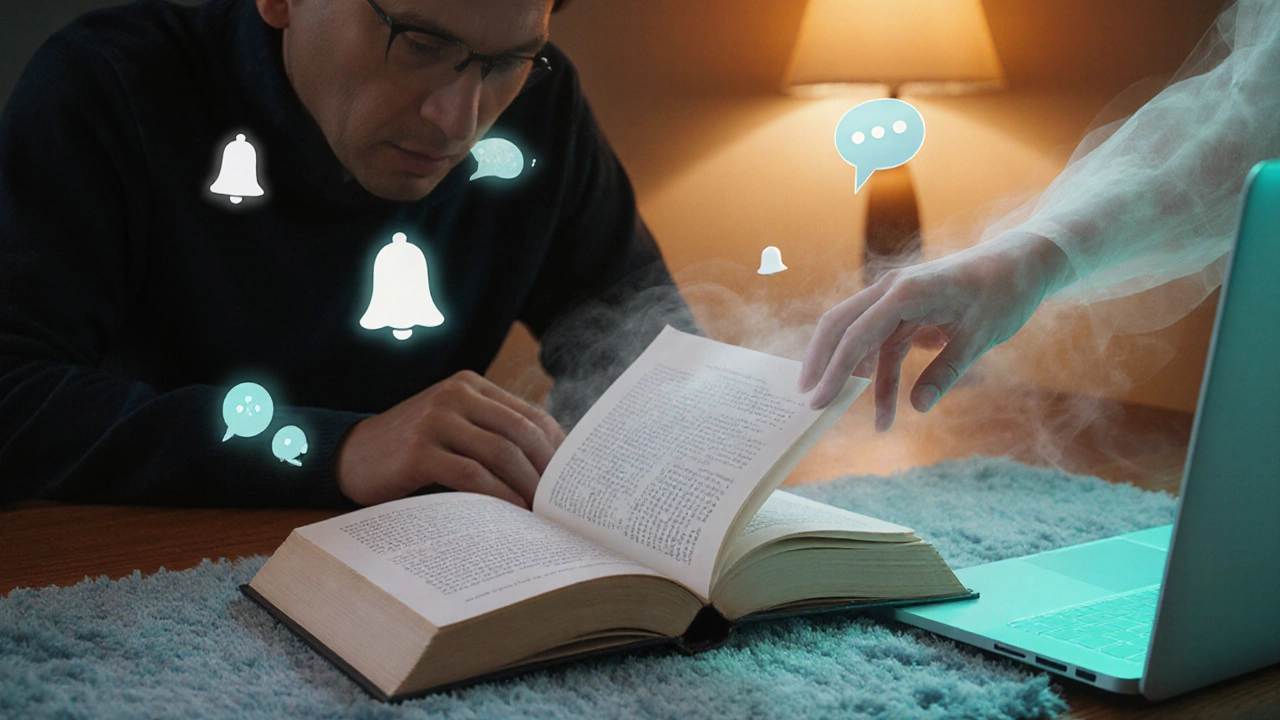Ghost Reading Self-Assessment Tool
Answer the following questions about your reading habits to assess if you're prone to ghost reading. This tool will help you understand your patterns and suggest strategies to improve completion rates.
Your Ghost Reading Assessment
Quick Takeaways
- Ghost reading is when you start a book and then stop engaging with it without finishing.
- It’s driven by digital overload, short‑attention spans, and the lure of newer titles.
- Signs include abandoned bookmarks, unread chapters, and disappearing notes.
- The trend affects authors, publishers, and even book‑club dynamics.
- Practical steps - set clear goals, limit distractions, and use reading‑analytics tools - can curb ghost reading.
Ever opened a novel, skimmed a few pages, and then never returned to it? That disappearing act is called ghost reading. It’s the literary equivalent of “ghosting” someone in a relationship - you engage briefly, then vanish without a trace. In a world where a fresh e‑book drops daily, understanding why readers ghost books is key for anyone who loves to read or works in publishing.
What Exactly Is Ghost Reading?
Ghost reading is a behavior where a reader begins a book-whether print, e‑book, or audiobook-and then abandons it without completing the narrative, often without any formal ‘finished’ status. Unlike simply putting a book on a shelf, ghost reading is marked by a deliberate start (a bookmark, a progress bar, or a note) followed by an abrupt halt. The term surfaced on reading‑forum threads in 2022 and has since been cited in industry reports as a growing "reading fatigue" symptom.
How Ghost Reading Differs From Similar Phenomena
Readers sometimes confuse ghost reading with a digital detox, binge reading, or normal book abandonment. The table below clarifies the nuances.
| Behavior | Typical Trigger | Completion Rate | Key Indicator |
|---|---|---|---|
| Ghost reading | Information overload, novelty pull | 0‑30% | Bookmark left untouched for >30days |
| Digital detox | Conscious break from screens | Varies (often 100% if planned) | Intentional pause announced |
| Binge reading | Series release or cliffhanger | 80‑100% | Multiple chapters completed in < 24hrs |
| Standard abandonment | Loss of interest over months | 30‑60% | No bookmarked progress, no notes |
Why Readers Ghost Books
Three main forces push readers toward ghost reading:
- Digital overload the constant stream of notifications, social‑media scrolls, and new content releases that fragment attention. When a phone buzzes at a crucial plot twist, the brain often chooses the newer stimulus.
- Reading fatigue a cumulative sense of mental exhaustion from prolonged reading sessions, especially on backlit screens. Studies from 2023 show screen‑based reading can reduce comprehension by up to 15% after 45minutes.
- Novelty pull the psychological pull toward newer titles, driven by algorithmic recommendations on platforms like Kindle Unlimited. The dopamine hit of a fresh cover can eclipse the lingering plot of a current book.
How to Spot Ghost Reading in Your Own Habit
If you’re unsure whether you’re a casual reader or a ghost reader, check these tell‑tale signs:
- Bookmarks or progress bars linger in the same spot for weeks.
- Notes or highlighted sections stop abruptly mid‑chapter.
- Reading‑analytics apps (e.g., Reading analytics software that tracks time spent per book) show sharp drop‑offs after the first 10‑15% of the book.
- You recall the title but not key plot points or characters.
Impact on the Publishing Industry
The rise of ghost reading isn’t just a personal quirk; it reshapes sales forecasts and marketing budgets. Publishers now monitor Book abandonment rates the proportion of started books that never reach completion via retailer data APIs. A 2024 report highlighted a 12% increase in abandonment for mid‑list titles, prompting a pivot toward shorter, episodic releases.
For authors, ghost reading can skew engagement metrics. A debut novelist might see strong launch numbers but low completion, signalling that the story’s hook isn’t sustaining reader interest. Consequently, many editors now request “read‑through” testing where beta readers simulate real‑world distracted environments.
Practical Strategies to Beat Ghost Reading
- Set micro‑goals. Instead of “read the whole book this week,” aim for “three chapters per day.” Small targets reduce the intimidation factor.
- Use a Reading timer a simple countdown app that signals when to pause. The Pomodoro technique (25‑minute focus blocks) works well for both print and e‑books.
- Limit background notifications. Put your phone on “Do Not Disturb” during reading slots to curb the digital overload trigger.
- Choose the right format. If screen fatigue is a problem, switch to a physical book or an audiobook for longer sessions.
- Leverage community accountability. Join a Book club a group that meets regularly to discuss progress. Knowing you’ll discuss the next chapter keeps momentum alive.
Real‑World Example: A Young Adult Series Turned Ghost Phenomenon
In 2023, a popular YA series launched three installments within six months. Initial sales were stellar, but analytics revealed a 45% ghost reading rate after the first book. Readers reported “getting distracted by the hype of the next release.” The publisher responded by releasing supplemental short stories that tied directly into each chapter, effectively re‑engaging readers and cutting the ghost rate to 18% for the sequel.
Key Takeaway
Ghost reading is a symptom of our hyper‑connected lives-new content, constant alerts, and shrinking attention spans. By recognizing the triggers, monitoring progress, and adopting focused reading habits, you can turn a ghost into a loyal literary companion.
Frequently Asked Questions
Is ghost reading the same as abandoning a book?
Not exactly. Abandoning a book can happen after a few pages with no intent to return. Ghost reading starts with a clear intent-bookmark, notes, or progress tracking-then vanishes without a formal finish.
Can ghost reading affect my reading comprehension?
Yes. When you drop a narrative mid‑way, the brain never completes the story arc, which can lower retention and the ability to discuss themes later.
Do audiobooks cause more ghost reading?
Audiobooks can reduce screen fatigue, but they also make it easy to switch tracks-listen while commuting, then pause for a new podcast. The same ghosting triggers apply if you don’t set listening goals.
How can I measure my own ghost reading rate?
Track the number of books you’ve started (a bookmark, a progress bar) versus the number you’ve marked "finished." Apps like Goodreads, StoryGraph, or built‑in Kindle stats give a clear start‑to‑finish ratio.
Will cutting back on social media help reduce ghost reading?
Reducing social‑media interruptions lowers digital overload, one of the biggest ghost‑reading triggers. Even a 30‑minute phone‑free reading window each day can boost completion rates substantially.

